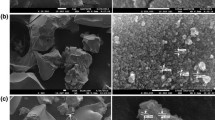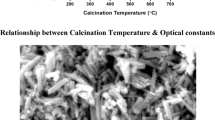Abstract
In this work, nanoparticles of titanium dioxide (TiO2) were synthesized by means of TiCl4 as precursor. Effects of alcohol type, calcination, gelatinizing time and microwave exposure on the particle size, morphology, crystallinity and particle phase are studied using XRD patterns and SEM images. Results showed that alcohols such as ethanol increased the particle size; calcination increased the particle size and improved the crystallinity of particles. Microwave exposure of particles resulted in smaller particles; adding water increased the impact of microwave. Effect of microwave exposure in rutile phase formation is also observed during this study.
Similar content being viewed by others
Introduction
Titanium dioxide (TiO2) has been widely used in various technological applications such as photocatalytic layers [1], diodes [2], sensors [3], cosmetics [4] and solar cells [5]. Therefore, TiO2 nanoparticles can be synthesized in order to use in diverse methods like laser ablation [6], RF thermal plasma [7], hydrothermal method [8], mechanochemical [9], the ultrasonic technique [10], metal organic chemical vapor deposition method [11] and sol–gel process [12, 13]. The sol–gel process is vastly used for the formation of TiO2 Nano-powder. It also involves many complex processes for both chemical and structural nature [14]. Generally, this process is a wet-chemical technique for the production of nano-materials starting both colloidal particles and chemical solutions to fabricate an integrated network [15]. The sol–gel method consists of the transmission of a system from a liquid phase (sol) toward a solid phase (gel). The various precursors such as organic alkoxides and acetates, in addition to inorganic salts like chlorides are utilized for synthesis of nanoparticles. Alcohols are greatly used among various kinds of solvents and also other solvent like benzene is used for some alkoxides. Moreover, some parameters such as the order of addition of reactants, the temperature, the solubility of reagents in the solvent and the pH affect homogeneity of the gel [16].
In this study, sol–gel method is used to synthesis of TiO2 nanoparticles due to ease of production, low cost and low experiment temperature. TiO2 nanoparticles synthesis was done in different situations such as using various kinds of alcohols, subjecting to microwaves, particle calcination and also different gelatinizing times. Several properties of particles such as particle size, homogeneity, crystallinity and particle phase which are significant characteristics of particles in technological applications were studied using SEM and XRD. X’Pert Pro MPD was exploited for XRD pattern and Hitachi s4160 for SEM.
Experiment
In order to synthesize TiO2 nanoparticles by sol–gel method, TiCl4 was used as the precursor. TiCl4 was slowly added to alcohol located on the stirrer with 2500 rpm speed. The alcohol was ethanol (C2H5OH), isopropanol (C3H7OH) and butanol (C4H9OH) in each separate sample. TiCl4/alcohol molar ratio was 1:10 ml/min. In this study E = Ethanol, I = Isopropyl and B = Butanol. In the next steps, synthesis of samples is classified in three groups:
Group (1): after the mentioned process, the solution was left at room temperature for gelling; some of them for 1 day (E1, I1 and B1) and some one for 7 days (E7, I7 and B7) then, they were dried in oven (80 °C) and powdered. The calcination process was performed in the chamber by temperature of 450 °C. Group 1 samples are listed as follows:
-
E1C (Ethanol, 1 day placed at room temperature with calcination), I1C, B1C, E7C, I7C and B7C.
Group (2): the instruction is similar to the group 1 in exception of adding water (W) to the samples with same ratio before placing them at room temperature (for 1 and 7 days as mentioned before). Then, the samples were subjected to microwave in 2450 MHz for 30 s. A single sample was also subjected to microwave for 30 s without water. Samples of this group are listed as follows:
-
E7CWM30, I7CWM30 and E7CM30.
Group (3): at the first, samples of this group were subjected to microwave for 150 s (M150) and then were placed in centrifuge (400 rpm) in order to separate the liquid part of the solution (CF). In this process, the liquid phase of the solution aggregates on the surface of the solution. It was detached and 2 cc of alcohol (same as the first group) was added to the solution and subjected to microwave again. This step was repeated for three times. Then the solution was placed in oven for 30 min at 80 °C. The produced sample was then pounded and turned into powder. Some of the samples were placed in chamber at 450 °C for calcination. These samples are listed as follows:
-
CFE1CM150, CFI1CM150, CFE1M150 and CFI1M150.
Results and discussion
When the TiO2 nanoparticles were synthesized, the impressive factors on the size and homogeneity and formation of different phases of TiO2 (i.e. the solute alcohol in TiCl4, adding water to the primary solution, subjecting to microwave before the primary solution is dried, leaving them for definite days to be dried, calcination and also using centrifuge and microwave for synthesis) were investigated. The results are described as follows:
Using different alcohols (ethanol, butanol and propanol)
As mentioned in experimental section, different alcohols are used for sol formation. Figure 1a and b shows the XRD pattern corresponding to three groups of synthesis which all of them are similar with exception of using alcohol.
Using Debye–Scherrer’s formula, \( \left( {L\; = \frac{K\lambda }{\beta \cos \theta }} \right) \) size of particles for three samples was calculated according to Fig. 1a corresponded to butanol, isopropanol and ethanol as 26, 30 and 32 nm, respectively. The size of particles is also calculated as 25, 30, and 33 nm for the samples of Fig. 1b which are synthesized with butanol, isopropanol and ethanol, respectively. The synthesis of these three samples is similar to the samples of Fig. 1a, however, the only difference between samples of Fig. 1b is using different alcohols. In this formula, K (Scherrer’s constant) is 0.89 for TiO2 [17], β is full width at half maximum intensity and θ is the angle. It is clear that the size of particles with respect to the using alcohol can be sorted as: \( {\text{ethanol}}\;{ > }\;{\text{isopropanol}}\;{ > }\;{\text{butanol}} \). By considering the structure of these alcohols, ethanol (C2H5OH), isopropanol (C3H7OH) and butanol (C4H9OH), it can be concluded that existence of smaller and more active –OH and –C2H5 groups in ethanol, is the reason for good reaction with TiCl4 and it causes polymer precursor with high degree of polymerization to be formed. The –C2H5 group in precursor can eliminate H2O well [18]. Eliminating water molecule causes the more agglomeration of Titania molecules and formation of larger nanoparticles. This sequence also holds for other two alcohols.
Because of difference in size of particles, remarkable diversities are also seen in homogeneity of particles. Homogeneity of the synthesized sample include of butanol was higher than ethanol one. SEM images of these two samples are shown in Fig. 2a and b.
Number of leaving days to be dried at room temperature (gelatinizing time)
Figure 3a, b and c shows the XRD pattern of the samples differing only in leaving days to be dried. One sample was left for 1 day and the other one for 7 days. Using Debye–Scherrer’s relation, the size of particles was calculated as about 30 nm according to Fig. 3a. For samples of Fig. 3b, 1 day left sample 33 nm and 7 days left sample 32 nm and also for Fig. 3c, 1 day left sample 25 nm and 7 days left sample 26 nm.
SEM images related to the samples of Fig. 3c are shown in Fig. 4a and b. In this image the homogeneous size distribution of particles can be seen. In fact, leaving the samples to be dried has not affected on the size of particles. According to unchanged size of samples during the various gelatinizing times, it can be deduced that the synthesized nanoparticles are highly stable.
Calcination
To study the effect of calcination on the size of particles, two types of similar synthesis were implemented. The only difference between these types is that one single sample was not calcinated. Figure 5a and b shows the related XRD patterns. Size of particles was calculated 10 nm for uncalcinated sample and 28 nm for the calcinated sample of Fig. 5a. For the uncalcinated sample of Fig. 5b, the size was calculated as 11 and 21 nm for the calcinated sample. Comparison between the XRD patterns of Fig. 5a and b, shows the sharp peaks after calcination. It shows that calcination increases the both of crystallinity of samples and size of particles. The results are similar to the research of Luis et al. [19].
The SEM images of samples relating to Fig. 5b are shown in Fig. 6a and b. According to the size of particles after calcination, homogeneity of uncalcinated sample Fig. 5a is higher than the calcinated one Fig. 5b.
Microwave
As mentioned in experimental section, some samples were subjected to microwave after adding water for 30 s. Figure 7a and b shows the XRD patterns of different samples only in microwave effect. According to the sample include of water and microwave effects, the size of particles is calculated as 20 nm which is shown in Fig. 7a and 30 nm for the sample without water and microwave effect. It is also calculated as 25 nm for Fig. 7b, the sample include of water and microwave and 32 nm for the sample without water and microwave. Finally, using water and microwave effect before getting dried, cause the smaller particles.
The XRD patterns of two samples are shown in Fig. 8 having the only difference in adding water before subjecting to microwave. For the sample included water before microwave effect, the particle size is calculated as 25 nm and for the no water sample as 28 nm. It shows that adding water before microwave effect, decreases the particle size. The SEM images of the later samples are shown in Fig. 9a and b which clarifies that homogeneity in no water sample is higher than the included one.
As explained before, centrifuge and microwave were used in synthesis of some samples. Discussions of this section are related to the effect of microwave on the particle size in this synthesis method. The XRD patterns of the samples with and without microwave are shown in (Fig. 10a, b). Using the Debye–Scherrer’s equation, the particle size for the sample of Fig. 10a with microwave is calculated as 28 nm and the sample without microwave as 30 nm. For the samples of Fig. 10b, with microwave it is calculated as 21 nm and without microwave 32 nm. Obviously the effect of microwave on samples is the formation of smaller particles, as mentioned. Since the frequency of microwave was 2450 MHz, about the vibration frequency of water molecules, energy is absorbed in water and transferred to nanoparticles. As the kinetic energy of particles increases, the probability of particles agglomeration decreases and therefore the size of TiO2 nanoparticles is decreased. Similar results of microwave effect on particle size are previously reported by Z. Ounaies et al. on during the study of Lead Zirconate Titanate [20].
Particle phase
In some cases of scientific applications, the phase of TiO2 particles is of great important [21]. Titanium dioxide, TiO2, is an important photocatalytic material that exists in two main polymorphs, anatase and rutile. The presence of either or both of these phases impacts on the photocatalytic performance of the material. In this work, the weight percentage of rutile phase is calculated by the following equation:
where I a and I r are the peak intensity of the (101) and (110) planes for the anatase and rutile phase, respectively [15]. Table 1 shows the percentage of the anatase phase for each sample.
Conclusion
TiO2 nanoparticles were synthesized by sol–gel method using TiCl4 as precursor. The results showed that using ethanol led to smallest size TiO2 nanoparticle formed among three kinds of alcohols, and then the propanol and finally the largest particles were corresponding to the butanol. Stability of nanoparticles caused the particle size to be remained unchanged during the various gelatinizing times. Calcination improved the crystallinity and increased the size of particles. Microwave exposure resulted in smaller particles and in some cases, caused the formation of rutile phase.
References
Zouzelka, R., Kusumawati, Y., Remzova, M., Rathousky, J., Pauporté, T.: Photocatalytic activity of porous multiwalled carbon nanotube–TiO2 composite layers for pollutant degradation. J. Hazard. Mater. 317, 52–59 (2016)
Chiou, A.H., SD, Wu, Hsiao, R.C., Hsu, C.Y.: TiO2–silicon nanowire arrays for heterojunction diode applications. Thin Solid Films 616, 116–121 (2016)
Arafat, M.M., Haseeb, A.S., Akbar, S.A., Quadir, M.Z.: In-situ fabricated gas sensors based on one dimensional core-shell TiO2–Al2O3 nanostructures. Sens. Actuators B 238, 972–984 (2017)
Su, C.Y., Tang, H.Z., Chu, K., Lin, C.K.: Cosmetic properties of TiO2/mica–BN composite powder prepared by spray drying. Ceram. Int. 40, 6903–6911 (2014)
Zhao, Z., Alford, T.L.: The optimal TiO2/Ag/TiO2 electrode for organic solar cell application with high device-specific Haacke figure of merit. Sol. Energ. Mat. Sol. C 157, 599–603 (2016)
Zimbone, M., Cacciato, G., Buccheri, M.A., Sanz, R., Piluso, N., Reitano, R., La Via, F., Grimaldi, M.G., Privitera, V.: Photocatalytical activity of amorphous hydrogenated TiO2 obtained by pulsed laser ablation in liquid. Mat. Sci. Semicon. Proc. 42, 28–31 (2016)
Collette, S., Hubert, J., Batan, A., Baert, K., Raes, M., Vandendael, I., Daniel, A., Archambeau, C., Terryn, H., Reniers, F.: Photocatalytic TiO2 thin films synthesized by the post-discharge of an RF atmospheric plasma torch. Surf. Coat. Tech. 289, 172–178 (2016)
Chen, N., Li, Y., Deng, D., Liu, X., Xing, X., Xiao, X., Wang, Y.: Acetone sensing performances based on nanoporous TiO2 synthesized by a facile hydrothermal method. Sens. Actuators B 238, 491–500 (2017)
Xiao, P.F., Lai, M.O., Lu, L.: Electrochemical properties of nanocrystalline TiO2 synthesized via mechanochemical reaction. Electrochim. Acta 76, 185–191 (2012)
Yang, J., Zhang, X., Li, B., Liu, H., Sun, P., Wang, C., Wang, L., Liu, Y.: Photocatalytic activities of heterostructured TiO2–graphene porous microspheres prepared by ultrasonic spray pyrolysis. J. Alloy. Compd. 584, 180–184 (2014)
Xu, H., Feng, X., Luan, C., Ma, J.: Preparation and characterization of single crystalline anatase TiO2 epitaxial films on LaAlO3 (001) substrates by metal organic chemical vapor deposition. Scripta Mater. 124, 76–80 (2016)
Wang, Q., Wei, X., Dai, J., Jiang, J., Huo, X.: Influence of annealing process on ferromagnetism of undoped TiO2 nanoparticles prepared by sol–gel method. Mat. Sci. Semicon. Proc. 21, 111–115 (2014)
Lin, W.D., Liao, C.T., Chang, T.C., Chen, S.H., Wu, R.J.: Humidity sensing properties of novel graphene/TiO2 composites by sol–gel process. Sens. Actuators B 209, 555–561 (2015)
Sahdan, M.Z., Nafarizal, N., Dahlan, S.H., Mahmoud, M.E., Hasim, U.: Sol–gel synthesis of TiO2 thin films from in-house nano-TiO2 powder. Adv. Mat. Phys. Chem. 2(04), 16 (2013)
Azizi, R., Rasouli, S., Ahmadi, N.P., Jafari jafar kolaei, A., Azizi, M.: A systematic investigation of experimental conditions on the particle size and structure of TiO2 nanoparticles synthesized by a sol–gel method. J. Ceram. Process Res. 13, 164–169 (2012)
Ahmad, E.H., Awan, G.H., Aziz, S.: Synthesis and applications of Tio2 nanoparticles, Pakistan Engineering Congress. In: 70th Annual Session Proceedings p 404 (2006)
Bahar, M., Gholami, M., Azim-Araghi, M.E.: Sol–gel synthesized Titania nanoparticles deposited on porous polycrystalline silicon: improved carbon dioxide sensor properties. Mat. Sci. Semicon. Proc. 26, 491–500 (2014)
Zhu, Y., Zhang, L., Gao, C., Cao, L.: The synthesis of nanosized TiO2 powder using a sol-gel method with TiCl4 as a precursor. J. Mater. Sci. 16, 4049–4054 (2000)
Luis, A.M., Neves, M.C., Mendonça, M.H., Monteiro, O.C.: Influence of calcination parameters on the TiO2 photocatalytic properties. Mater. Chem. Phys. 125, 20–25 (2011)
Ounaies, Z., Selmi, F., Varadan, V.K., Varadan, V.V., Megherhi, M.: Microwave calcination of conventionally and sol–gel prepared lead zirconate titanate. Mater. Lett. 17, 13–20 (1993)
Luttrell, T., Halpegamage, S., Sutter, E., Batzill, M.: Photocatalytic activity of anatase and rutile TiO2 epitaxial thin film grown by pulsed laser deposition. Thin Solid Films 564, 146–155 (2014)
Author information
Authors and Affiliations
Corresponding author
Rights and permissions
Open Access This article is distributed under the terms of the Creative Commons Attribution 4.0 International License (http://creativecommons.org/licenses/by/4.0/), which permits unrestricted use, distribution, and reproduction in any medium, provided you give appropriate credit to the original author(s) and the source, provide a link to the Creative Commons license, and indicate if changes were made.
About this article
Cite this article
Bahar, M., Mozaffari, M. & Esmaeili, S. Effect of different alcohols, gelatinizing times, calcination and microwave on characteristics of TiO2 nanoparticles synthesized by sol–gel method. J Theor Appl Phys 11, 79–86 (2017). https://doi.org/10.1007/s40094-017-0240-5
Received:
Accepted:
Published:
Issue Date:
DOI: https://doi.org/10.1007/s40094-017-0240-5














